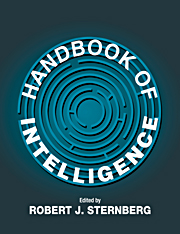Book contents
- Frontmatter
- Contents
- Preface
- Contributors
- PART I THE NATURE OF INTELLIGENCE AND ITS MEASUREMENT
- PART II DEVELOPMENT OF INTELLIGENCE
- PART III GROUP ANALYSES OF INTELLIGENCE
- PART IV BIOLOGY OF INTELLIGENCE
- PART V INTELLIGENCE AND INFORMATION PROCESSING
- PART VI KINDS OF INTELLIGENCE
- 16 Social Intelligence
- 17 Practical Intelligence
- 18 Models of Emotional Intelligence
- PART VII TESTING AND TEACHING INTELLIGENCE
- PART VIII INTELLIGENCE, SOCIETY, AND CULTURE
- PART IX INTELLIGENCE IN RELATION TO ALLIED CONSTRUCTS
- Author Index
- Subject Index
16 - Social Intelligence
Published online by Cambridge University Press: 05 June 2012
- Frontmatter
- Contents
- Preface
- Contributors
- PART I THE NATURE OF INTELLIGENCE AND ITS MEASUREMENT
- PART II DEVELOPMENT OF INTELLIGENCE
- PART III GROUP ANALYSES OF INTELLIGENCE
- PART IV BIOLOGY OF INTELLIGENCE
- PART V INTELLIGENCE AND INFORMATION PROCESSING
- PART VI KINDS OF INTELLIGENCE
- 16 Social Intelligence
- 17 Practical Intelligence
- 18 Models of Emotional Intelligence
- PART VII TESTING AND TEACHING INTELLIGENCE
- PART VIII INTELLIGENCE, SOCIETY, AND CULTURE
- PART IX INTELLIGENCE IN RELATION TO ALLIED CONSTRUCTS
- Author Index
- Subject Index
Summary
The capacity to know oneself and to know others is an inalienable a part of the human condition as is the capacity to know objects or sounds, and it deserves to be investigated no less than these other “less charged” forms.
Howard Gardner (1983, p. 243) Frames of MindIntelligence, as defined in standard dictionaries, has two rather different meanings. In its most familiar meaning, intelligence denotes the individual's ability to learn and reason. It is this meaning that underlies common psychometric notions such as intelligence testing, the intelligence quotient, and the like. In its less common meaning, intelligence refers to a body of information and knowledge. This second meaning is implicated in the titles of certain government organizations such as the Central Intelligence Agency in the United States and its British counterparts MI–5 and MI–6. Similarly, both meanings are invoked by the concept of social intelligence. As originally coined by E. L. Thorndike (1920), the term referred to the person's ability to understand and manage other people and to engage in adaptive social interactions. More recently, however, Cantor and Kihlstrom (1987) redefined social intelligence as the individual's fund of knowledge about the social world.
THE PSYCHOMETRIC VIEW
The psychometric view of social intelligence has its origins in E. L. Thorndike's (1920) division of intelligence into three facets: the ability to understand and manage ideas (abstract intelligence), concrete objects (mechanical intelligence), and people (social intelligence).
- Type
- Chapter
- Information
- Handbook of Intelligence , pp. 359 - 379Publisher: Cambridge University PressPrint publication year: 2000
- 102
- Cited by



